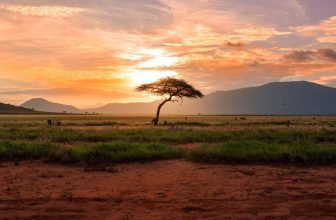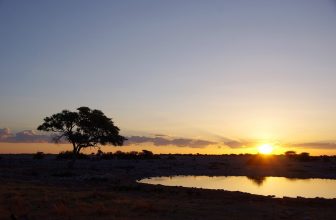During a game drive in Kenya, you may have a tough time telling a black rhino from a white rhino. Both are in the Rhinocerotidae family and are grey in color, so it is vital you know the five features that tell the two species apart.
A sighting of these enormous plant-eating mammals will likely be a highlight of your time in the wild. Read on to discover the major differences between the two rhinoceros species.
White Rhinoceros vs Black Rhinoceros
The white rhino, ceratotherium simum, and black rhino, diceros bicornis, are the two main species of rhinoceros found in Africa. The black rhino was the most numerous of the world’s rhino species before it was relentlessly hunted.
Black rhinos live in savanna, shrubland, and desert areas in Angola, Botswana, Kenya, Malawi, Mozambique, Rwanda, Namibia, South Africa, Tanzania, Zambia, and Zimbabwe. While white rhinos live in savanna, shrubland, and grassland in Botswana, Namibia, South Africa, Uganda, and Zimbabwe.
The white rhino has two subspecies, the Northern white rhino and the Southern white rhino, while there are three distinct subspecies of black rhino living in Africa.These are the southern-eastern black rhino, eastern black rhino, and south-western black rhino. The western black rhino (a fourth subspecies) lived in the Masai Mara and was declared extinct in 2011.
Although rhinos have been struggling, the numbers of both rhino species have been increasing in countries where there are considerable investments in conservation. Monitoring at-risk wildlife and working with law enforcement has helped Kenya, Namibia, South Africa, and Zimbabwe conserve the remaining wild black rhino populations.

Threats to White Rhino and Black Rhino
The main threat to rhino populations is poaching to supply the illegal rhino horn trade. The demand for rhino horn stems from traditional Chinese medicine and ornaments. Illegal hunting has not only affected the white rhino population directly, it has also indirectly lowered the live sale price and investment incentive.
The black rhino faces a similar threat from poaching and has also seen a decrease in habitat as private reserves have less incentive to own rhino with the increased protection costs.
As many as 75 rhinos are sport-hunted in Africa per year. Prior to implementing new measures in 2012, 18% of the rhino horn reaching the illegal trade came from sport hunting in South Africa.
Is the White or Black Rhino endangered?
The white rhino is considered ‘near threatened’ while the black rhino population, as classified by the International Union for Conservation of Nature, is critically endangered.
How many White and Black Rhinos are left?
While the difference between black and white rhino populations is straightforward, the status of these species is more complex. There are only two individual northern white rhinos remaining, while southern white rhinos are estimated to have a population of 10,080 adults.
Black rhino numbers decreased by 98 percent between 1960 and 1995 to less than 2,500 individuals. Fortunately, the population is increasing and has grown to 5,630 adults.
South Africa’s National Parks are home to the world’s largest rhino population. There are just 3,529 white rhinos and 268 black rhinos left. Despite losing 394 rhino to poaching in 2024, South Africa has seen a year-on-year decrease in the number of poached rhino.

What is the Difference Between the Black and White Rhino?
If you are lucky, you can see both the white and black rhino on a game drive during a Kruger National Park safari. Your guide can tell the two species apart, but will you be able to? Here are the main differences between the black and white rhino.
Appearance of Black Rhino vs White Rhino
Depending on the distance from the rhino and the individual animal you observe, you can use the animal’s appearance to determine if it is a black or white rhino.
Upper Lip
- Black rhino: known as the hook-lipped rhino, it has a pointed upper lip. This helps them to feed on leaves from trees and bushes while browsing for food.
- White rhino: has a square-shaped upper lip that is suited to its grazing habits.
Head and Face Shape
- Black rhino: has a shorter forehead that appears to protrude from the animal’s face.
- White rhino: has a less defined forehead and a longer skull. It tends to hold its head a little lower than the black rhino – keeping it closer to the ground for grazing.
Shoulder hump
- Black rhino: has a hollow, saddle-shaped back with a sacral bump near to its rear.
- White rhino: has a large shoulder hump and a sacral bump two-thirds of the way to its rear.
Ears
- Black rhino: small and round
- White rhino: narrower and more pointed at the tips than black rhino ears.
Horns
- Black rhino: Each of the two horns is similar in length. A male black rhino tends to have a thicker horn, while females have longer horns.
- White rhino: The front horn is longer than a black rhino, while the second horn behind it is much shorter
Black vs White Rhino Size Comparison
The black rhino is smaller and sturdier than the white rhino. Adults measure up to 1.6m tall and weigh on average 800 to 1400 kg, while white rhinos measure up to 1.8m and weigh on average 2300 kg.
The white rhino can reach top speeds of 50km/h while the smaller black rhino can reach a top speed of 55km/h, only slightly slower than the top speed of a giraffe.
Behaviour of a White vs Black Rhino
White rhinos are social and live in groups of seven individuals or more. They tend to graze along the ground with heads hanging low.
The black rhino is occasionally seen in groups of up to five. However, it usually lives alone. It browses for food, reaching up to leaves on trees and shrubs above the ground.

White and Black Rhino Facts
Here are some interesting white and black rhino facts for you to remember:
- The white rhino is the second-largest land mammal after the elephant
- The word rhinoceros is a Greek word meaning ‘nose’ and ‘horn’
- White rhino live to between 40-50 years in the wild
- Black rhino live to between 35-50 years in the wild
- The females Najin and Fatu are the last two northern white rhino
- Rhino horn costs as much per gram as gold on the black market
Is it a White Rhino or Black Rhino?
During your next game drive, we hope you can confidently identify which type of rhino you encounter. With the five simple characteristics mentioned above, you should be well on your way to knowing which grey mammal is which. Now all you have to do is book your all-inclusive safari in Africa and you’re ready to go rhino spotting.
Have you seen a white or black rhino in the wild? Share your experience with us in the comments below.






